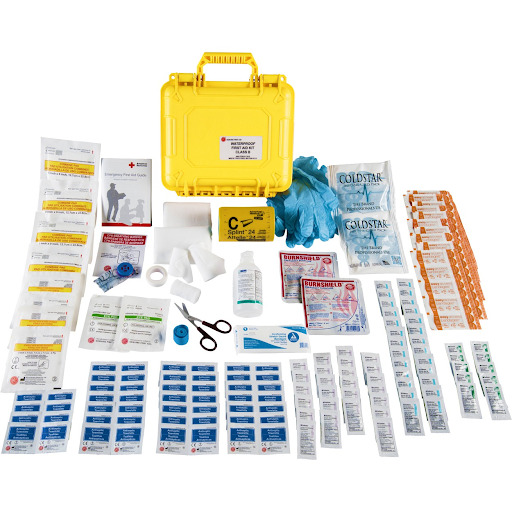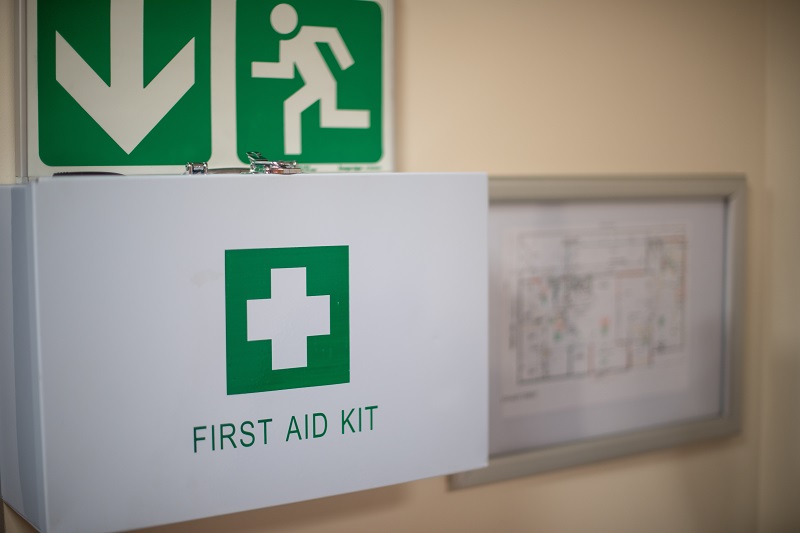Many injuries occurring in a workplace environment will typically demand immediate, once-off and short-term medical attention. This is what is known as first aid and OSHA directs employers to provide first aid supplies appropriate to the hazards of the workplace.
Therefore, employers must facilitate a hazard assessment to determine the individualized workplace first aid kits with supplies appropriate to injuries that can occur.
Here’s everything you need to know about OSHA first aid kit requirements in the workplace.

What First Aid Kits Do Different Workplaces Require?
The American National Standard Institute (ANSI) has a recommended list of the minimum requirements for workplace first aid kits.
The first aid supplies are adequate for common workplace injuries and illnesses such as:
- major wounds,
- minor wounds (cuts and abrasions),
- minor burns,
- sprains and strains, and
- eye injuries.
ANSI has detailed two different classes of work environments that require different first aid supplies.
Class A caters for employees such as those working in an office, warehouse, or doing packaging. The injuries that might occur include minor cuts, abrasions, and sprains.
Class A ANSI Minimum Requirements | ||
Quantity | Item | Size |
16 | Adhesive Bandages | 1”x3” |
1 | Adhesive Tape | 2.5 yds |
10 | Antibiotic Treatment Application | 1/57 oz |
10 | Antiseptic Applications | 1/57 oz |
1 | Breathing Barrier | |
1 | Burn Dressing, gel soaked | 4”x4” |
10 | Burn Treatment | 1/32 oz |
1 | Cold Pack | |
2 | Eye Covering | |
1 | Eye Wash | 1 oz |
1 | First Aid Guide | |
6 | Hand Sanitizer | .9g |
2 | Pair Exam Gloves | |
1 | Roller Bandage | 2”x4 yds |
1 | Scissors | |
2 | Sterile Pad | 3”x3” |
2 | Trauma Pad | 5”x9” |
1 | Triangular Bandage | 40”x40”x56” |
Class B has first aid supplies more appropriate to more complex injuries that can occur at more high-risk environments such as industrial manufacturing, welding, woodwork, fabrication or printing.
Class B ANSI Minimum Requirements | ||
Quantity | Item | Size |
50 | Adhesive Bandages | 1”x3” |
2 | Adhesive Tape | 2.5 yds |
25 | Antibiotic Treatment Application | 1/57 oz |
50 | Antiseptic Applications | 1/57 oz |
1 | Breathing Barrier | |
2 | Burn Dressing, gel soaked | 4”x4” |
25 | Burn Treatment | 1/32 oz |
2 | Cold Pack | |
2 | Eye Covering | |
1 | Eye Wash | 4 oz |
1 | First Aid Guide | |
10 | Hand Sanitizer | .9g |
4 | Pair Exam Gloves | |
2 | Roller Bandage | 2”x4 yds |
1 | Roller Bandage | 3”x4 yds |
1 | Scissors | |
1 | Splint | 4”x24” |
4 | Sterile Pad | 3”x3” |
1 | Tourniquet | |
4 | Trauma Pad | 5”x9” |
2 | Triangular Bandage | 40”x40”x56” |
Once the hazard assessment has occurred, the Class A or Class B kits must be supplemented with adequate first aid supplies appropriate to the identified hazards.
What Are Safety Managers Responsible For?
A first aid leader should be appointed to manage the first aid program. They are responsible for ensuring the workplace first aid kits are up to standard.
It is good practice for a first aid leader to stock first aid kits with more supplies than necessary. For example, if the first aid kit is required to have one gel soaked burn dressing and an employee needs to use it, there may be no dressing left in the kit should another employee require one. Or more commonly, if something was found to be expired, it might take a few days for the new product to be delivered.
OSHA doesn’t give specifics on how regularly the first aid kits should be inspected, so the first aid leader should do so weekly, bi-weekly or monthly depending on how regularly the first aid supplies are used.
The first aid leader must make an inventory checklist, and every time supplies get removed or replaced, it must be recorded.
Expiration dates must be checked at every inspection, so recording them on the inventory can make future checks both quicker and easier.
First aid leaders should arrange any color-coded first aid supplies in the first aid kits into color-coded boxes for better organization:
- blue: antiseptics,
- yellow: bandages,
- red: burn treatment,
- orange: personal protective equipment, and
- green: miscellaneous items.

Where Should Workplace First Aid Kits Be Installed?
Workplace first aid kits must be readily accessible by personnel who have first aid training.
Timely first aid is crucial to provide any temporary treatments of injuries until the employee can reach a physician or hospital.
This means personnel shouldn’t have to go through several hallways or up or down stairs to reach the first aid kit as it wastes valuable time.
A good rule of thumb to follow is that every elevation or change in departments should have additional first aid kits.
Although not always possible, it can be handy to place first aid cabinets close to a sink so the first aid provider can wash their hands before use. A good location can be outside locker rooms, close to the wash fountain.
Where the first aid kits are installed is also dependent on the type of work environment:
- Type I: intended for indoor settings, so containers are mountable and stationary,
- Type II: intended for indoor use but portable,
- Type III: must be portable, mountable and have a water-resistant seal.
- Type IV: Must be portable, mountable and waterproof.

How Insure Compliance Can Help
Insure Compliance assists employers to find the safety gaps in their company. We perform a gap analysis using our Safety Gap Model to identify the weak links putting occupational safety and health at risk.
When it comes to first aid kit requirements, the safety gaps that could be present include:
- Awareness gap: knowing the OSHA first aid kit requirements appropriate for your workplace.
- Process gap: detailing first aid kit requirements policies in a first aid program.
- Knowledge gap: enforcing the first aid program.
- Verification gap: evaluate the first aid program’s effectiveness by engaging with employees and inspecting first aid leader behavior.
- Accountability gap: keep first aid leaders accountable for first aid program violations.
After identifying the safety gaps, we help companies strengthen those weak links to reduce the chance of OSHA violations resulting in penalty fees. Many times, this begins with training.
We provide first aid training which covers:
- how to identify symptoms of medical emergencies,
- how to react to minor and major medical emergencies,
- cardiopulmonary resuscitation (CPR), and
- first aid kit and inventory management requirements.
Key Takeaways
All workplaces, no matter what industry, require first aid kits. But, different industries must add additional supplies appropriate to their environment to ensure optimal occupational safety and health.
Therefore, a hazard assessment must be performed to identify the nature of the injuries that can occur in your workplace. The first aid equipment must be able to provide medical attention to these.
A first aid leader must be appointed, and it’s their responsibility to:
- maintain the first aid program,
- set up the first aid kits with the appropriate supplies,
- ensure there is adequate stock at all times,
- periodically inspect the first aid kits, and
- install the first aid kits in readily accessible locations.
The first aid leader requires sufficient training to be able to perform their job, or else your company is at risk of violating OSHA standards.
Contact us today if you need assistance with meeting OSHA first aid kit requirements.
Disclaimer:
Please note that every effort has been made to ensure that the information provided in this guide is accurate. You should note, however, that the information is intended as a guide only, providing an overview of general information available to businesses. This guide is not intended to be an exhaustive source of information and should not be seen to constitute legal, safety or business advice. You should, where necessary, seek your own advice for any issues raised in your affairs.








One Response
I’m so glad you talked about the importance of having first aid kits in a working space! In my opinion, any company must have its own first aid kit and a professional emergency attendant! If I owned an industrial plant, I’d be sure to do everything I can to protect my employees! Thanks for the information on how each workplace requires a different type of first aid kit!